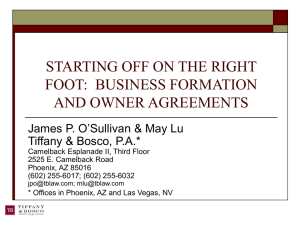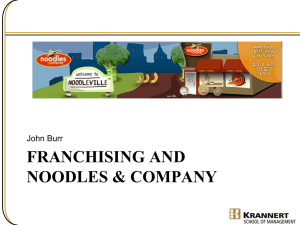Man 470(Entrepreneurship)
advertisement
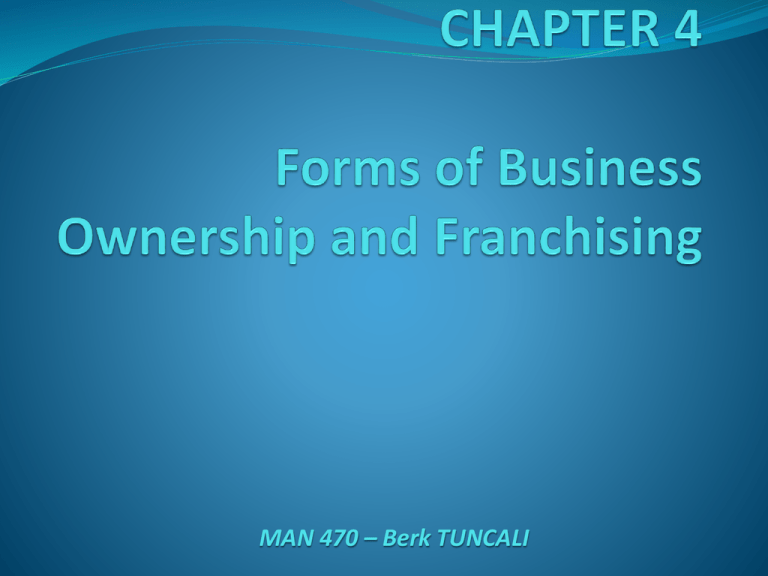
MAN 470 – Berk TUNCALI Things to consider when choosing; Tax consideration Liability exposure Startup capital requirement Control Business goals Management succession plan Cost of formation Sole Proprietorship A business owned and managed by one individual. Most popular 18 million in the US $ 1 Trillion in sales 73% of the companies in the US Advantages of Sole Proprietorship Simple to create (fast and easy) Least costly form of ownership (fees and licenses) Profit incentive (all the profit is kept after the expenses) Total decision making authority No special legal restrictions (least regulated) Easy to dissolve Disadvantages of Sole Proprietorship Unlimited personal liability Unlimited personal liability is a situation in which the sole proprietor is personally liable for all of the business’s debts. Limited skills and capabilities Feelings of isolation (no help or feedback) Limited access to capital Lack of Continuity for the business (if Proprietor dies’ so does the business) Where do small business owners turn for advice? Spouse – 62% of the time Son – 11% of the time Father – 9.5% of the time Brother – 8.8% of the time Who else??? The Partnership Partnership is an association of two or more people who co-own a business for the purpose of making profit. Partnership Agreement is a document that states in writing all of the terms of operating the partnership and protects the interest of each partner. A Partnership Agreement may include the following; Name of the partnership Purpose of business Domicile of the business Duration of the partnership Names of the partners and addresses Contributions of each partner to the business How the profits and losses will be distributed Salary details Expansion details Advantages of Partnership Easy to establish (easy and inexpensive) Complementary skills (two hands better than one) Division of profits (according to the agreement) Larger pool of capital Ability to attract limited partners Little governmental regulation Flexibility Taxation General Partners: partners who share in owning, operating and managing a business and who have unlimited personal liability for the partnership’s debts. Limited Partners: partners who do not take an active role in managing a business and whose liability for the partnership’s debts is limited to the amount they have invested. Disadvantages of Partnership Unlimited liability of at least one partner Capital accumulation (cannot sell shares to generate capital) Difficulty in disposing of partnership interest without dissolving the partnership (if a partner dies or quits, new partner will come in or gets bought over. Otherwise the business dissolves.) Lack of continuity (death and inheritance of new partner) Potential for personality and authority conflicts (like marriage - compatibility) Limited Partnerships A partnership composed of at least one general partner and at least one limited partner. Same rules apply as before The partner who is limited will only loose the amount invested in the business if the things turn out for the worst. Limited Liability Partnerships A special type of limited partnership in which all partners are limited partners. They are known as LLPs Usually limited to professionals such as attorneys, dentists, accountants. Master Limited Partnerships A partnership whose shares are traded on stock exchange, just like a corporation’s. Corporations Corporation is a separate legal entity apart from its owners that receives the right to exist from the state in which it is incorporated. Domestic Corporation: corporation doing business in the state it is incorporated. Foreign Corporations: corporation doing business in a state other than the one in which it is incorporated. Alien Corporation: a corporation formed in another country but doing business in a different country. Advantages of Corporations Limited liability of Stockholders Ability to attract capital Ability to continue indefinitely (unless it fails) Transferable ownership (shares are easily sold) Disadvantages of Corporations Cost and time involved in the incorporations process Double taxation (corporate’s tax + stockholder’s tax) Potential for diminished managerial incentives (managers not having the same level of interest as the founder. Profit sharing or stock ownership is exercised to beat this trait) Legal requirements and regulatory red tape (annual reports and legal reporting necessary) Potential loss of control by the founder(s) (owners sell their stocks to gather capital but let of part of their ownership) ie. Microsoft was a partnership between Paul Allen and Bill Gates in 1975. Mr. Gates had 50% but they went public to gather capital and as a result he was left with 18.5% ownership. The S Corporation This is the same as the regular C corporation but allows the corporation a tax advantage by being taxed as a Partnership, hence getting rid of double taxation. This is only valid in the US. It has certain rules such as; Corporation must be domestic Shareholders must be residents No more than 75 shareholders Limited Liability Company (LLC) This is a cross between a partnership and a corporation. All LLCs must have at least two owners. LLCs offer limited liability to owners and also avoids double taxation. Less paperwork compared to Corporations. However, they are expensive to create. It is harder to raise capital from investors due to limited liability. Joint Venture In any endeavor in which neither party can effectively achieve the purpose alone, a joint venture becomes a common form of ownership. Joint venture is a business agreement in which parties agree to develop, for a finite time, a new entity and new assets by contributing equity. Example: Concert at a underperforming farm! FRANCHISING Franchising is the practice of using another firm's successful, tried and tested business model. A system of distribution in which semi-independent business owners (Franchisees) pay fees and royalties to a parent company (Franchiser) in return for the right to become identified with its trademark, to sell its products or services and use its business format. Types of Franchising Trade name franchising – purchases the right to use the franchiser’s trade name. Product distribution franchising – licenses to sell franchiser’s products. (petrol stations) Pure franchising – buys the complete business format and system from the franchiser. (McDonald’s) Benefits of buying a Franchise Management training and support (McDonald’s University) Brand name appeal (internationally recognized – golden arches) Standardized quality of goods and services (years of reputation) National advertising programs (benefits all franchisers – must pay 1-5% monthly advertisement costs) Financial assistance (initial costs can be so high that franchisor usually offer financial assistance) Proven products and business formats (tried and tested) Centralized buying power (economies of scale) Site selection and territorial protection (location, location, location) Greater chance for success (less risky than starting from scratch) Good site for current information; http://www.entrepreneur.com/franchises/index.html McDonald’s Subway Drawbacks of buying a Franchise Franchise fees and profit sharing Strict adherence to standardized operations (no autonomy) Restrictions on purchasing (dictated what to buy) Limited product line (cannot create your own) Unsatisfactory training programs (can be a pitfall) Market saturation (close proximity) Less freedom (reporting to a boss) The right way to buy a Franchise Evaluate yourself Research your market Consider your franchise options Talk to existing franchisees Ask the franchiser some tough questions Make your choice Trends shaping Franchising 1970s Fast food restaurants used this idea to grow rapidly. 1980s Economy shifted towards service sector. 1990s – Today Low cost franchising era. Trends shaping Franchising Changing face of Franchises Better educated franchisees who are more sophisticated, has more business understanding and are more financially secure. International opportunities Becoming major export industry and growing world wide. Trends shaping Franchising Non traditional locations Try to build smaller and less expensive stores while utilizing intercept marketing. Intercept marketing is the principle of putting the franchise’s products or services directly in the patch of potential customers wherever they may be. (airports) Conversion franchising – a trend in which the small business owners become franchisees to gain the advantage of name recognition. Multiple unit franchising – this is a popular trend in which one franchisee opens more than one store. (sometimes as much as 200 stores) Master franchising – a method of franchising that gives a franchisee the right to create a semi-independent organization in a particular territory to recruit, sell and support other franchises. Piggybacking (Combination franchising) Combining two or more franchises under one roof. Eg. Serving aging baby boomers Time saving businesses ideas are on the rise who serve the aging baby boomers. ‘‘Around Your Neck’’ selling clothes to people at their work or home. THANK YOU
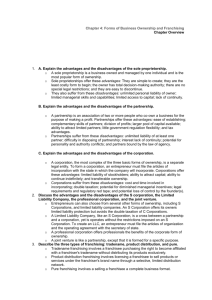
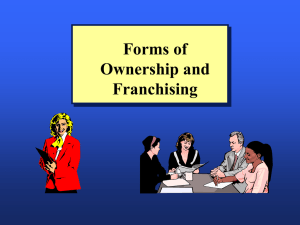
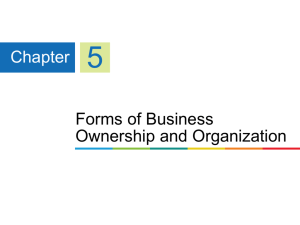



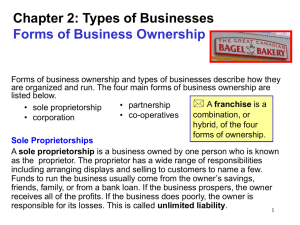

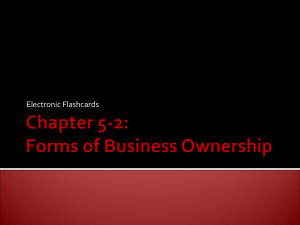
![[10]. Accessing Resources for Growth from External Sources](http://s2.studylib.net/store/data/005546472_1-5ce4dc20e590c3a704ef63f6f22a5a81-300x300.png)
